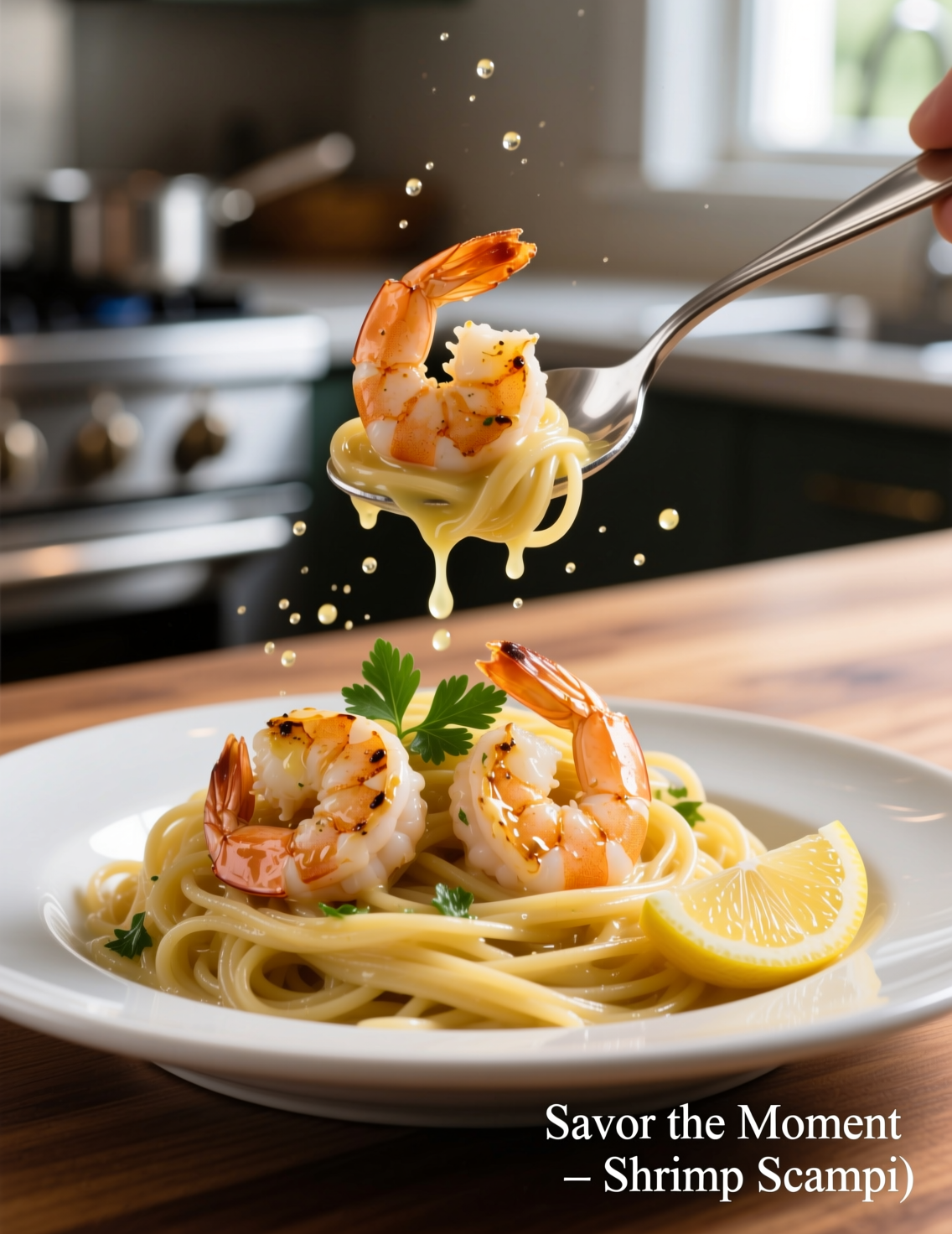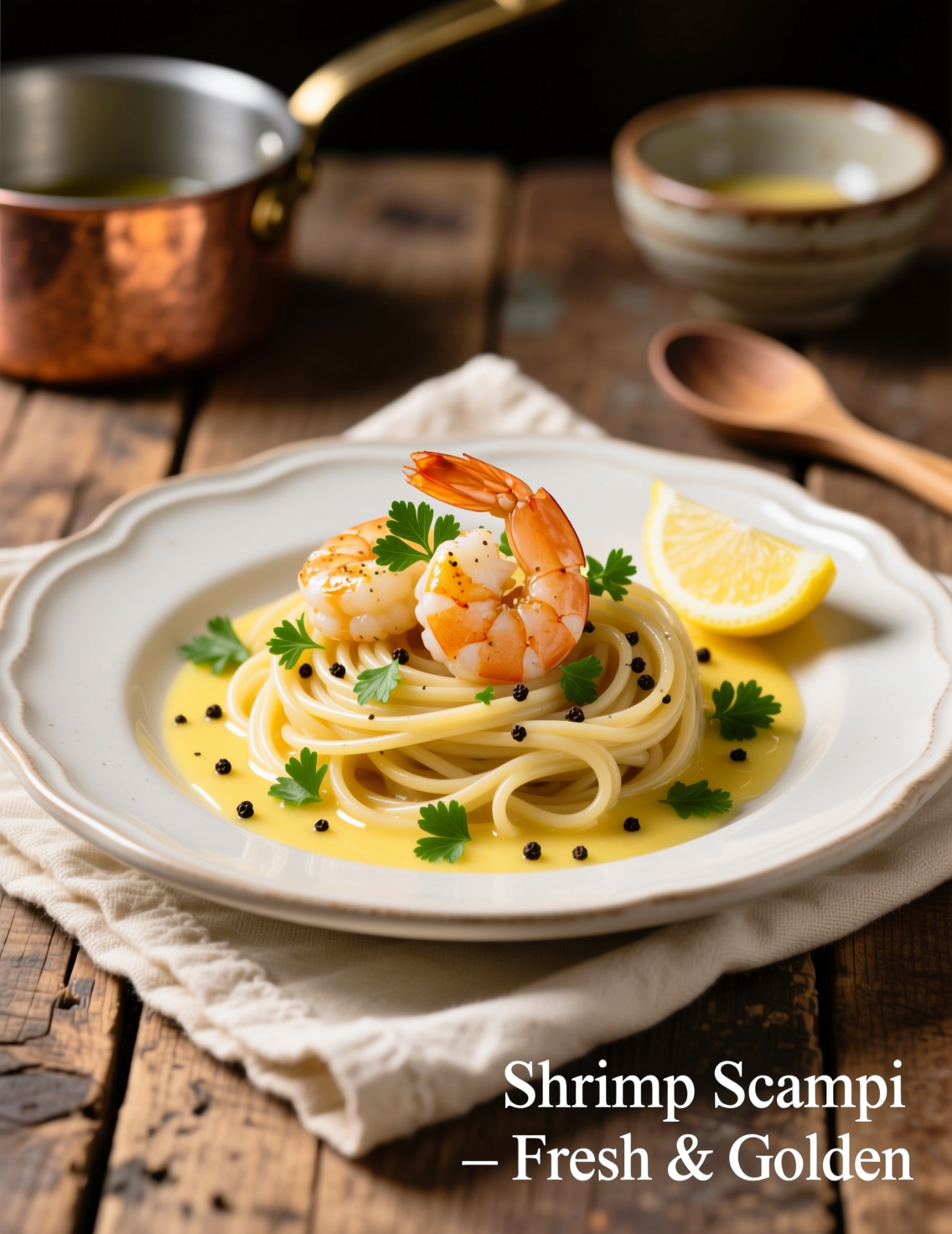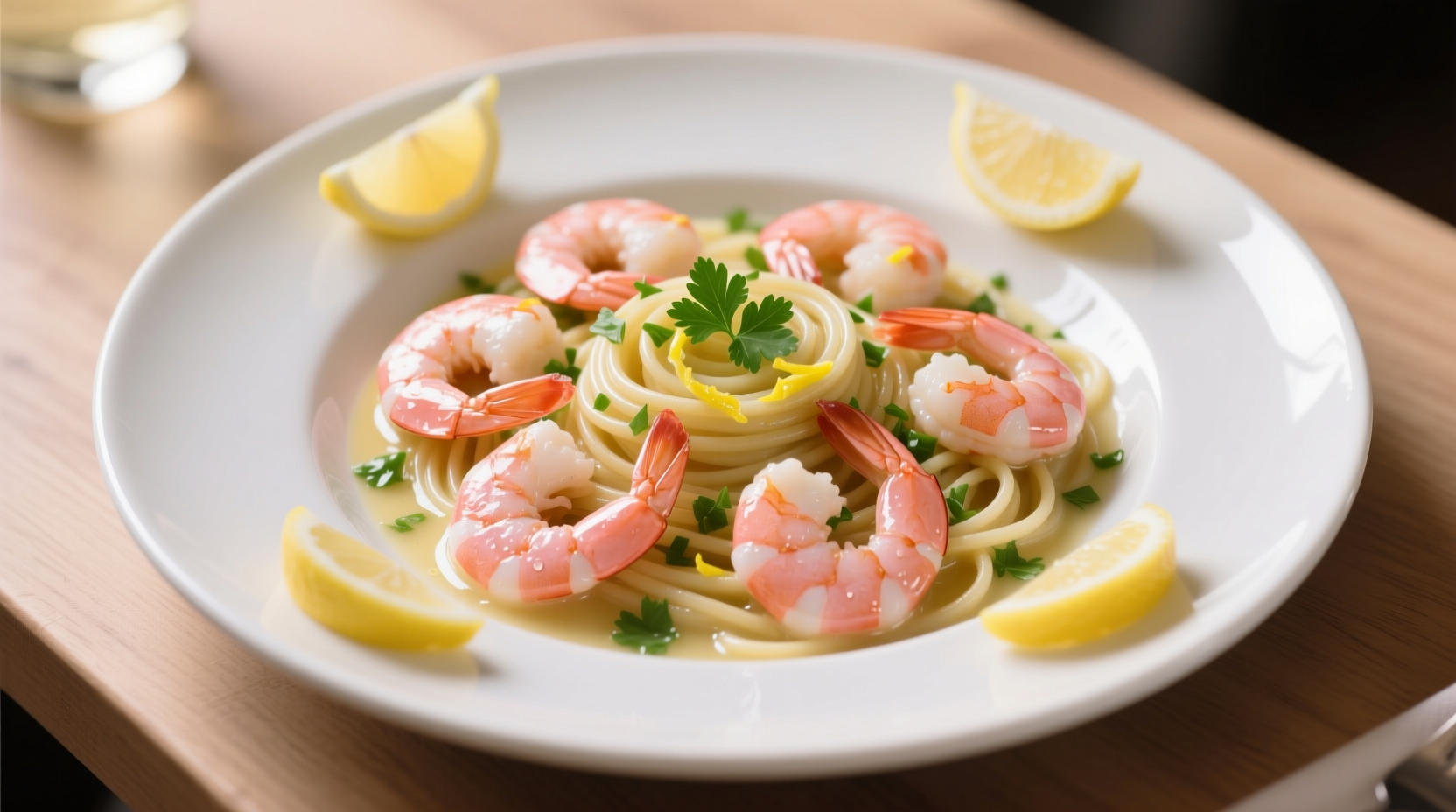There are recipes that come and go. Then there’s shrimp scampi, the kind of dish that slips onto the table and somehow steals the whole evening. If you’ve ever twirled pasta with buttery garlic shrimp wrapped around it, you know exactly what I mean. In this article, I’ll walk you through not just how to make an easy shrimp scampi for 6 servings, but also why certain techniques matter, what pitfalls to avoid, and even a bit of history that makes this dish more than just dinner.
Why Shrimp Scampi Is Always a Winner
Shrimp scampi is one of those recipes that looks fancy but cooks faster than a weekday stir-fry. In the restaurant world, it’s a workhorse. Chefs lean on it because the dish delivers comfort and elegance in about 20 minutes flat. Shrimp, butter, garlic, lemon, parsley—this isn’t a shopping list that intimidates anyone.
The phrase “scampi” actually comes from Italian, referring originally to langoustines, a cousin of the lobster. When Italian immigrants arrived in America, they swapped those hard-to-find shellfish with shrimp. The recipe evolved but kept the name. Funny how language sticks even when ingredients change.
Ingredients Matter More Than Recipes
This is where pros quietly nod. You can’t hide poor-quality shrimp under garlic and butter. For a 6-serving recipe, you’ll need about 2 pounds of large shrimp, peeled and deveined. Frozen shrimp? Yes, absolutely. Most “fresh” shrimp you see in markets were frozen anyway and thawed on-site. If you thaw them yourself, you control the process, and you keep the shrimp firmer.
Butter is non-negotiable. Go for unsalted because you’ll want to regulate seasoning yourself. Garlic? Freshly minced. Never the jarred stuff—it tastes flat, almost metallic, and it ruins the fragrance that’s supposed to hit the pan the second garlic touches hot fat. White wine should be dry, something crisp like Sauvignon Blanc. You’re not looking to spend $30, but if you wouldn’t sip it, don’t pour it in your pan.

Exact Recipe: Easy Shrimp Scampi for 6 Servings
Ingredients
- 2 pounds large shrimp (peeled and deveined, tails optional)
- 6 tablespoons unsalted butter
- 3 tablespoons olive oil
- 6 garlic cloves, finely minced
- 1 cup dry white wine (or chicken stock as substitute)
- Juice and zest of 1 lemon
- 1 teaspoon crushed red pepper flakes (adjust to taste)
- Salt and freshly ground black pepper, to taste
- 1/2 cup fresh parsley, chopped
- 1 pound linguine or spaghetti
Method
- Cook pasta in salted boiling water until just al dente. Save 1/2 cup pasta water, drain the rest.
- Heat 3 tablespoons butter with the olive oil in a wide skillet.
- Add shrimp in a single layer, season lightly with salt and pepper, and cook until just pink, about 2 minutes per side. Transfer shrimp out.
- Add garlic to skillet. Sauté quickly, about 30 seconds—don’t burn it.
- Deglaze with white wine, scraping up browned bits. Reduce by half, around 2–3 minutes.
- Stir in lemon juice, zest, red pepper flakes, and the remaining butter. Swirl until emulsified.
- Return shrimp to pan, toss with sauce, then fold in pasta. Add a splash of pasta water if needed to loosen.
- Finish with parsley, check seasoning, serve immediately.
The entire dish from start to finish takes about 25 minutes. That’s the charm—it’s quick but feels celebratory.
Professional Notes That Make the Difference
Shrimp cooks incredibly fast. Overcook them by even one minute and you’re eating rubber bands. The key is to pull them just as they curl into a C-shape. If they look like an O, you’ve gone too far. A quick tip: cook them in two batches if your skillet feels crowded. Crowded pans steam shrimp instead of searing them.
Wine reduction isn’t optional. It creates depth and gives the sauce body. Don’t rush this part. Letting the alcohol cook off while concentrating flavors is what makes the scampi sauce taste restaurant-level. Some chefs sneak in a splash of fish stock for an umami kick, but that’s advanced territory.
And here’s something people don’t talk about often. Adding pasta water isn’t just about loosening the sauce. That starchy liquid bonds everything together. Without it, shrimp scampi sometimes feels like pasta with oily shrimp sitting on top. With it, the sauce hugs every strand.
Pairings and Serving
Shrimp scampi sings when paired with pasta, but rice or crusty bread works beautifully too. In fact, in parts of Italy, you’ll see scampi served with nothing but bread for soaking. If you’re aiming for a balanced plate, a simple arugula salad with lemon vinaigrette alongside keeps things fresh.
Wine pairing? Easy. Stick with dry whites. Pinot Grigio, Sauvignon Blanc, even a light Chardonnay if you want creamier notes. Red wine with shrimp scampi? A sommelier’s nightmare—red tannins clash with shellfish proteins and make them taste metallic. Stick to white.
Nutritional Profile
People sometimes shy away thinking butter plus pasta equals indulgence. True, it’s not “diet food.” But shrimp itself is low-calorie and high-protein. A 4-ounce serving of shrimp clocks around 120 calories with 24 grams of protein. The bulk of richness comes from butter and pasta. Moderation and portioning balance it out.
For a six-serving scampi with pasta, you’re looking at about 550–600 calories per serving, depending on butter and pasta type. Whole-grain linguine can add fiber. Using olive oil more heavily than butter can lighten it without stripping flavor.

Common Mistakes Cooks Make
Overloading garlic. Yes, garlic is the backbone, but raw acrid garlic kills the dish. Sauté it lightly, never let it brown.
Adding cheese. No Parmesan here. Italians don’t mix seafood and cheese in traditional dishes because the flavors fight.
Skipping acid. Lemon juice is not optional. Without it, the dish turns heavy and flat.
One more silent killer: reheating shrimp scampi. Shrimp hate the microwave. If you must reheat, do it gently on the stovetop with a splash of broth or water.
A Look at Shrimp Scampi in Restaurants
The National Restaurant Association listed shrimp scampi among the top-selling seafood pasta dishes in the U.S. in recent years. It shows up everywhere from fine dining menus to casual chains. Why? It’s adaptable. You can scale it for 2 people or 200. For catering, chefs sometimes bake shrimp scampi in trays, finishing with parsley right before service.
Interestingly, studies on consumer preference in seafood dishes show garlic-butter based sauces rank among the top 3 flavor profiles Americans associate with “luxury” yet “comforting.” Shrimp scampi nails both.
Variations and Modern Twists
Some chefs swap linguine for zucchini noodles for a low-carb spin. Others add cherry tomatoes, giving bursts of sweetness that balance the richness. There’s even a growing trend of spicy scampi, with Calabrian chili paste replacing red pepper flakes for deeper heat.
A professional trick I’ve seen? Finish with a drizzle of basil oil instead of parsley. It shifts the flavor without losing tradition. The dish is endlessly versatile, which explains its survival across decades of food trends.
Why This Recipe Works for 6 Servings
Scaling shrimp scampi isn’t just about multiplying ingredients. Shrimp behave differently in larger batches. For 6 people, two pounds is perfect because it ensures enough protein without overcrowding pans. Pasta at one pound hits the sweet spot of balance between shrimp and starch. Six servings also align well with bottle sizes—one standard 750ml bottle of wine provides just enough for cooking plus glasses at the table. That’s efficiency chefs quietly love.
Conclusion
Shrimp scampi, done right, is proof that simplicity still wins. With just a few fresh ingredients, the dish carries itself like fine dining while staying approachable for home kitchens. For six servings, balance is everything—enough shrimp to go around, pasta that carries sauce properly, and restraint with butter so flavors shine instead of smother.
What professionals know, and what home cooks should remember, is that scampi is less about recipe cards and more about touch. Watch the shrimp, taste the sauce, adjust seasoning on the fly. That’s where the magic lies. Next time you need to feed a small crowd fast but still impress, this easy shrimp scampi will get you there.
FAQs
Can I make shrimp scampi without wine?
Yes, you can replace wine with chicken stock or seafood broth for similar depth.
What pasta works best with shrimp scampi?
Linguine is classic, but spaghetti or angel hair work just as well.
How many shrimp do I need for 6 servings?
About 2 pounds of large shrimp, which usually gives around 24–30 pieces.
Can I use frozen shrimp for scampi?
Yes, just thaw properly in the fridge or under cold water before cooking.
How do I stop shrimp from getting rubbery?
Cook them quickly until they curl into a C-shape and remove immediately.
Is cheese allowed in shrimp scampi?
No, traditional scampi avoids cheese because it clashes with seafood flavors.
What wine pairs best with shrimp scampi?
Dry white wines like Sauvignon Blanc or Pinot Grigio pair beautifully.
Can I make shrimp scampi ahead of time?
It’s best cooked fresh since reheating shrimp makes them tough.
How do I thicken the scampi sauce?
Use reserved pasta water—it binds sauce and coats pasta evenly.
Is shrimp scampi healthy?
Shrimp is lean and high-protein, but butter and pasta make it calorie-rich.
What’s the origin of shrimp scampi?
It started with Italian immigrants adapting langoustine scampi using shrimp in America.
Can I make shrimp scampi spicy?
Yes, increase red pepper flakes or add Calabrian chili paste for heat.

Mariana is a passionate home cook who creates delicious, easy-to-follow recipes for busy people. From energizing breakfasts to satisfying dinners and indulgent desserts, her dishes are designed to fuel both your body and hustle.
When she’s not in the kitchen, she’s exploring new flavors and dreaming up her next recipe to share with the Foodie Hustle community.

